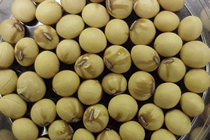By Loren J. Giesler, Former Extension Plant Pathologist
Pathogen
Bean pod mottle is caused by the comovirus Bean pod mottle virus. BPMV was first identified in Nebraska in 1981. The virus is transmitted most commonly by the bean leaf beetle in soybean. As the bean leaf beetle feeds the virus is transmitted as the beetle regurgitates previous plant material which has the virus and it is introduced into the feeding wound. It is not known how long feeding needs to occur for transmission to occur. Seed transmission has been documented, but appears to occur at a very low percentage (0.1%). Greater yield loss occurs when plants are infected early in development.
Plants with BPMV can also have higher levels of Phomopsis seed infection and produce discolored seed, which can have a significant impact on seed production. Yield reduction due to BPMV, has been documented to be as high as 52% in other states. A more recent study evaluating yield loss in Ohio and Nebraska documented an average yield loss of 16% when plants were inoculated at the VC to V3 growth stages.


Disease Symptoms
Symptoms of BPMV are green to yellow mottling (blotchiness) of younger leaves in the upper canopy. In severe cases leaves may show puckering and distortion and plants can be stunted. Pods can be misshapen with mottling and reduced in size. Infected plants may have green stems after the pods have matured. Seed from infected plants may appear smoky in color or have reduced size and quality due to seed coat mottling which will be brown or black depending on hilum color. The only way to confirm the presence of BPMV is with serological testing (ELISA).



Favorable Environmental Conditions
Symptoms appear during cool weather and rapid growth, may be masked at high temperature. Virus is transmitted by bean leaf beetles, so weather favorable for their overwintering will potentially increase this disease.
Beetles transmit BPMV efficiently for several days after feeding on an infected plant. The virus is known to increase in concentration in the beetles after continued feeding on infected plants by the beetles. The beetle can transmit the virus immediately after acquiring it, but is not able to transfer the virus to its offspring.
Management
Genetic Resistance
To date BPMV resistance has not been identified; however, varieties will respond differently to the virus. At this time varieties are not rated for susceptibility to BPMV.
Cultural Practices
Cultural practices such as late planting will reduce BPMV. The host range of BPMV is restricted mostly to legumes and it is thought that some perennial legumes may play a role it the over-wintering of the virus. The main source however is the bean leaf beetle
Chemical/Biological Control
Insecticide seed treatments and foliar sprays targeting management of the bean leaf beetle will reduce the incidence of BPMV. Remember that most of the damage is from early season introduction, so trying to manage this disease during the pod filling stages will not have as much impact as an early season management action. Insecticide Recommendations for Bean Leaf Beetle in Soybean
Additional Resources
- North Central Soybean Research and Information Initiative: Bean Pod Mottle Virus
